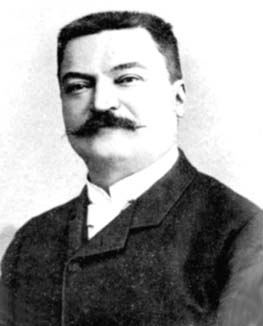
François Edouard Anatole Lucas
 المؤلف:
N T Gridgeman
المؤلف:
N T Gridgeman
 المصدر:
Biography in Dictionary of Scientific Biography
المصدر:
Biography in Dictionary of Scientific Biography
 الجزء والصفحة:
...
الجزء والصفحة:
...
 22-1-2017
22-1-2017
 709
709
Born: 4 April 1842 in Amiens, France
Died: 3 October 1891 in Paris, France

Edouard Lucas was educated at the École Normale in Amiens. After this he worked at the Paris Observatory under Le Verrier.
During the Franco-Prussian War (1870-1871) Lucas served as an artillery officer. After the French were defeated, Lucas became professor of mathematics at the Lycée Saint Louis in Paris. He later became professor of mathematics at the Lycée Charlemagne, also in Paris.
Lucas is best known for his results in number theory: in particular he studied the Fibonacci sequence and the associated Lucas sequence is named after him. He gave the well-known formula for the Fibonacci numbers
√5 fn = ((1 + √5)/2)n - ((1 - √5)/2)n.
Lucas also devised methods of testing primality, essentially those used today. In 1876 he used his methods to prove that the Mersenne number 2127 - 1 is prime. This remains the largest prime number discovered without the aid of a computer.
The Lucas test for primes was refined by Lehmer in 1930. It works as follows. Define the sequence
S2 = 4, S3 = 14, S4 = 194, . . .
where for n >2, Sn is defined inductively by
Sn = Sn-12 - 2.
The Lucas-Lehmer test states that a Mersenne number Mp = 2p - 1, with p > 2, is prime if and only if Mp divides Sp.
Lucas showed that S127 is divisible by M127 thus showing that M127 is prime. This was a extremely difficult calculation since M127 is a big number and S127 is unbelievably large. In fact
M127 = 170141183460469231731687303715884105727
and Lucas was only able to perform the calculation since he showed that S127 is divisible by M127 without calculating S127.
Lucas is also well known for his invention of the Tower of Hanoi puzzle and other mathematical recreations. The Tower of Hanoi puzzle appeared in 1883 under the name of M. Claus. Notice that Claus is an anagram of Lucas! His four volume work on recreational mathematics Récréations mathématiques (1882-94) has become a classic.
Lucas died as the result of a freak accident at a banquet when a plate was dropped and a piece flew up and cut his cheek. He died of erysipelas a few days later.
- N T Gridgeman, Biography in Dictionary of Scientific Biography (New York 1970-1990).
http://www.encyclopedia.com/doc/1G2-2830902693.html
Articles:
- D Harkin, On the Mathematical Works of François Edouard Anatole Lucas, Enseignement mathématique 3 (1957), 276-288.
- M R Williams, Edouard Lucas vindicated, Ann. Hist. Comput. 6 (4) (1984), 404.
 الاكثر قراءة في 1840to1849
الاكثر قراءة في 1840to1849
 اخر الاخبار
اخر الاخبار
اخبار العتبة العباسية المقدسة


